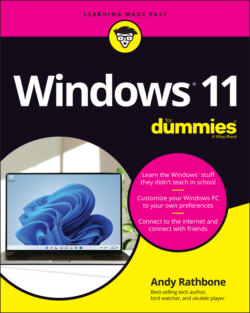Читать книгу Windows 11 For Dummies - Andy Rathbone - Страница 46
Bellying Up to the Taskbar
ОглавлениеWhenever more than one window sits across your desktop, you face a logistics problem: Programs and windows tend to overlap, making them difficult to spot. To make matters worse, programs such as web browsers and Microsoft Word can contain several windows apiece. How do you keep track of all the windows?
The Windows solution is the taskbar — a special area that keeps track of your currently running programs and their windows. Shown in Figure 3-4, the taskbar lives along the bottom of your desktop, constantly updating itself to show an icon for every currently running app or desktop program.
FIGURE 3-4: Move the mouse pointer over a taskbar icon to see that app’s currently open files.
The taskbar remains accessible along the screen’s bottom edge, even when apps or the Start menu fill the screen.
The taskbar also serves as a place to launch your favorite programs. By keeping your favorite programs’ icons in sight and one quick click away, you’re spared a detour to the Start menu.
Not sure what a taskbar icon does? Rest your mouse pointer over any of the taskbar icons to see either the program’s name or a thumbnail image of the program’s contents, as shown in Figure 3-4. In that figure, for example, you can see that the Photos app displays three photos.
From the taskbar, you can perform powerful magic, as described in the following list:
To play with a program listed on the taskbar, click its icon. The window rises to the surface and rests atop any other open windows, ready for action. Clicking the taskbar icon yet again minimizes that same window.
Whenever you load an app or program, its icon automatically appears on the taskbar. If one of your open windows ever gets lost on your desktop, click its icon on the taskbar to bring it to the forefront.
To close an app or program listed on the taskbar, right-click its icon and choose Close from the pop-up menu. The program quits, just as if you’d chosen its Exit command from within its own window. (The departing program thoughtfully gives you a chance to save your work before it quits and walks off the screen.)
Taskbar icons with a thin underline along their bottom edge let you know that their app or program is currently running.
Traditionally, the taskbar lives along your desktop’s bottom edge, but earlier Windows versions let you move it to any edge you want. That feature disappeared from Windows 11; the taskbar now stays firmly affixed to the screen’s bottom edge.
Can’t find an open app or window? Click the taskbar’s Task View icon (shown in the margin) to see thumbnails of all your open apps and programs. Click the one you want to revisit, and it rises to the top of the screen.
You can quickly jump to the taskbar page in the Settings app by right-clicking the taskbar and choosing Taskbar Settings.
If the taskbar keeps hiding below the screen’s bottom edge, rest the mouse pointer to the screen’s bottom edge until the taskbar surfaces. Then right-click the newly revealed taskbar and choose Taskbar Settings. When the Settings app opens to the Personalization page, scroll down to the Taskbar section. Click it to fetch the Taskbar page, and then click the Taskbar Behaviors menu and click the Automatically Hide The Taskbar option to remove its check mark.
You can add your favorite apps and programs directly to the taskbar: From the Start menu, right-click the favored program’s name or icon, and choose Pin To Taskbar from the pop-up menu. The program’s icon then lives on the taskbar for easy access, just as if it were running. Tired of the program hogging space on your taskbar? Right-click it and choose Unpin From Taskbar from the pop-up menu.
